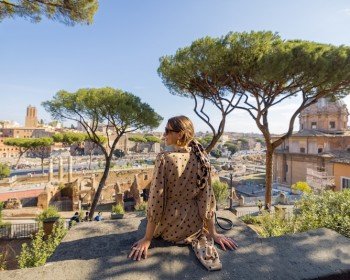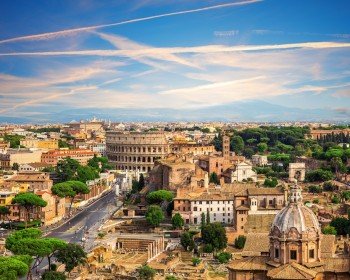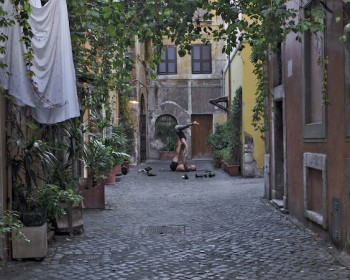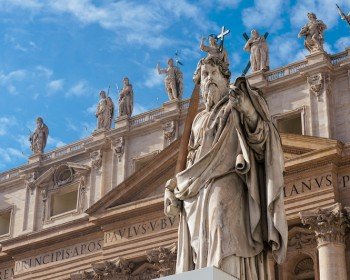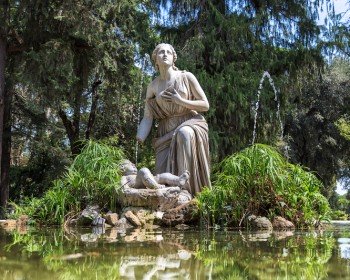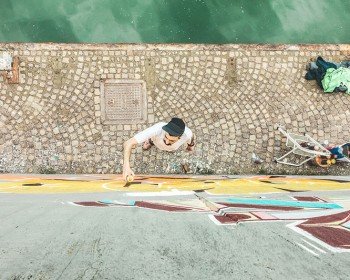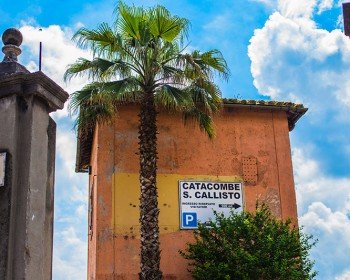Today I am going to talk about Testaccio. It is the twentieth rione and it is considered one of the most typical neighborhood in Rome. Walking down the streets its visitors can travel through the different eras: from ancient Rome until fascism and the industrial development. Though nowadays it is popular for the Roman nightlife and frequented by young people for the number of bars and pubs.
History
Located at the slope of the Aventine Hill, during the Roman period Testaccio hosted one of the most important river ports of the ancient Rome: the Emporium. Lots of cruise ships used to upload right there every sort of merchandise they transported. With the passing of the time fragments of the amphorae – called testae – used to transport mainly oil and wheat accumulated creating an artificial hill named “mons Testaceus” (Monte Testaccio).
From it the name of the neighborhood itself. Formerly inhabited by farmers and shepherds, after the reclamation in 1870, Testaccio became one of Rome’s working-class neighborhood assigned to industrial activities and services like railways, the slaughterhouse, markets and gas factory. The urban district was created especially for those who used to work there. Until than Testaccio was just “the Roman lawn” where people from the center used to have their Sunday trips.
It’s in 1921 that Testaccio is established as an administrative body, with the separation from the Ripa district.
- Pyramid of Cestius
It is something that will leave you speechless for sure! It is an ancient pyramid built about 18-12 b.C. as a tomb for Gaius Cestius, a magistrate member of one of the most important religious corporations in Rome. The story goes that it was built in 330 days or maybe less. De facto Gaius Cestius ordered that after his death his heirs would have had the pyramid built within that date, otherwise they would have lost their inheritance. The presence of a pyramidal funeral monument in Rome probably is due to the fact that Egypt had become a Roman province. From the 3rd century it is part of the Aurelian Walls of Rome.
- Porticus Aemilia
Enduring since 193 b.C. it was a portico in ancient Rome. One of the biggest commercial structures at that time, it functioned both as warehouse and distribution center for merchandise entering the city thanks to the Tiber river. Its construction coincides with the economic growth of the city – both in population and trades –. According to the history, it appears that the Porticus and the Emporium have been cooperating to facilitate the storage and the redistribution of goods until the 16th century.
- Porta San Paolo
It is one of the southern gates in the 3rd century Aurelian Walls. Formerly it was known as Porta Ostiensis because it was located at the beginning of via Ostiense that linked Rome to Ostia. It has a cylindrical tower per side, and had two entrances now covered by a single-opening gate. Renamed Porta San Paolo it was the exit of Rome that lead exactly to the Basilica of Saint Paul outside the Walls.
The 10th of September 1943 Porta San Paolo was the scene of the last attempt of the Italian army to stop the German occupation of Rome.
Discover our ➡️ The Life of St. Paul Private Tour in Rome
- Protestant Cemetery
It is a public cemetery right near Porta San Paolo. With Mediterranean cypress, pomegranate and other trees, and a grassy meadow, it is the burial place of non-Catholic, including Protestant or British people – though not exclusively!- Since the Catholic laws neglected to bury non-Catholic people, suicide victims and actors, after their death they were buried outside the walls of Rome. For example, the English poet John Keats and Percy Bysshe Shelley, and Antonio Gramsci - the leader of the Italian Communist Party - are buried there.
- Ex Mattatoio
It is the old slaughterhouse. Considered one of the most important examples of Roman industrial archaeology, it has been renovated many times, hosting temporary and permanent manifestations inside the old pavilions. Nowadays it is house to offices, classrooms for the Faculty of Architecture and seat of the MACRO (Museum of Contemporary Art of Rome), known as MACRO Testaccio.
- Centrale Montemartini
Located barely outside Testaccio district, the Montemartini thermoelectric power plant dated back to 1912. Being the first public electric plant, it was placed where the city was having its best development of industrial power: Testaccio. Away from the usual tourist routes, there you can really appreciate a visit in a sort of special Museum, combining arts and settings from different eras. The main characteristic of the museum is a peculiar mix of industrial archaeology and the classic one.
--> Discover more about Centrale Montermartini
You can reach Testaccio by underground, take the line B – the blue one – and get off at Piramide stop. Otherwise, the tram number 3 will bring you right at Piazzale Ostiense, or you can get there by train stopping at Roma Ostiense station. If you want to go by bus, you can calculate the route on the ATAC website.
Peculiarities
During the years the authenticity of the district has inspired many artists, poets and filmmakers. Think about the Italian famous writer Pier Paolo Pasolini whose works “Ragazzi di vita” and “Accattone” take place right there. Furthermore some of Ferzan Ozpetek’s movies are set in Testaccio, where he lives and works.
In addition to this, the district has always been known to be gay-friendly: in fact since 2002 the Mattatoio has been the scene of the first editions of Gay Village events.
Testaccio is a source of both archaeological pieces of evidence and histories of ancient everyday Roman life. Don’t forget to choose a night to spend there, the trend destination of the Roman nightlife. And don’t miss the chance to eat something new, lots of peculiar pubs are taking the place of old traditional restaurants!


